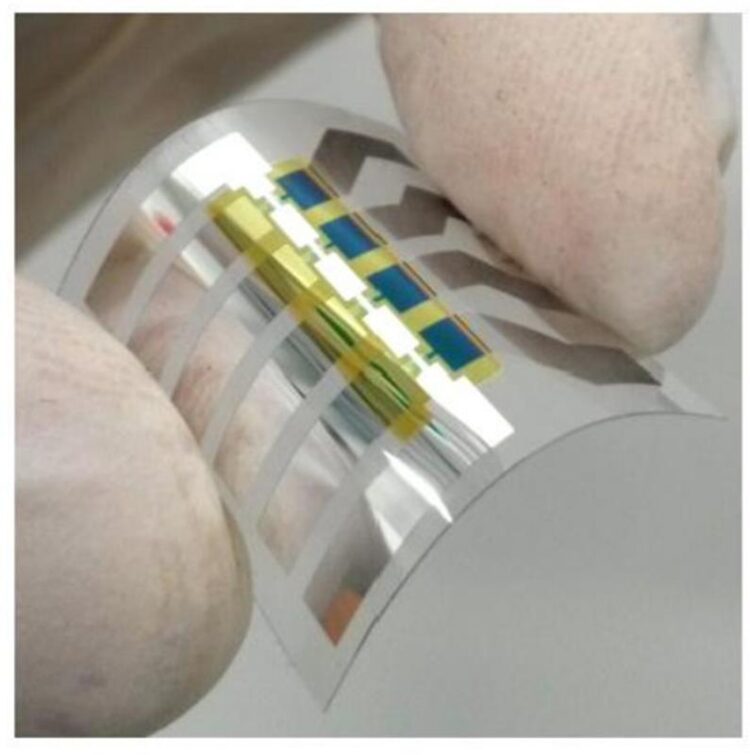Dresden physicists develop printable organic transistors

The team around Dr Hans Kleemann has succeeded for the first time in developing powerful vertical organic transistors with two independent control electrodes.
(c) IAPP
Scientists at the Institute of Applied Physics at TU Dresden have come a step closer to the vision of a broad application of flexible, printable electronics. The team around Dr Hans Kleemann has succeeded for the first time in developing powerful vertical organic transistors with two independent control electrodes. The results have recently been published in the renowned online journal “Nature Communications”.
High-definition roll-up televisions or foldable smartphones may soon no longer be unaffordable luxury goods that can be admired at international electronics trade fairs. High-performance organic transistors are a key necessity for the mechanically flexible electronic circuits required for these applications.
However, conventional horizontal organic thin-film transistors are very slow due to the hopping-transport in organic semiconductors, so they cannot be used for applications requiring high frequencies. Especially for logic circuits with low power consumption, such as those used for Radio Frequency Identification (RFID), it is mandatory to develop transistors enabling high operation frequency as well as adjustable device characteristics (i.e., threshold-voltage).
The research group Organic Devices and Systems (ODS) at the Dresden Integrated Center for Applied Photophysics (IAPP) of the Institute of Applied Physics headed by Dr. Hans Kleemann has now succeeded in realizing such novel organic devices.
„Up to now, vertical organic transistors have been seen as lab curiosities which were thought too difficult to be integrated in an electronic circuit. However, as shown in our publication, vertical organic transistors with two independent control electrodes are perfectly suited to realize complex logic circuits while keeping the main benefit of vertical transistors devices, namely the high switching frequency“, says Dr Hans Kleemann.
The vertical organic transistors with two independent control electrodes are characterized by a high switching frequency (a few nanoseconds) and an adjustable threshold voltage. Thanks to these developments, even single transistors can be used to represent different logical states (AND, NOT, NAND). Furthermore, the adjustable threshold voltage ensures signal integrity (noise margin) and low power consumption.
With this, the research group has set a milestone with regard to the vision of flexible and printable electronics. In the future, these transistors could make it possible to realize even sophisticated electronic functions such as wireless communication (RFID) or high-resolution flexible displays completely with organic components, thus completely dispensing with silicon-based electronic components.
Caption Figure 1: Upper panel: Layer sequence of an vertical organic permeable base transistor with two independently tunable base electrodes. Lower panel, left: Transfer-characteristics of such a transistor. Right: Adjustability of the turning-on voltage using the second base electrode.
Wissenschaftliche Ansprechpartner:
Dr. Hans Kleemann
Dresden Integrated Center for Applied Photophysics (IAPP) and
Institute of Applied Physics
Tel. +49 351 463-43379
Email: hans.kleemann1@tu-dresden.de
Originalpublikation:
Guo, E.; Wu, Z.; Darbandy, G.; Xing, S.; Wang, S.; Tahn, A.; Göbel, M.; Kloes, A.; Leo, K.; Kleemann, H. Vertical Organic Permeable Dual-Base Transistors for Logic Circuits. Nature Communications: http://dx.doi.org/10.1038/s41467-020-18576-5
Weitere Informationen:
Media Contact
All latest news from the category: Physics and Astronomy
This area deals with the fundamental laws and building blocks of nature and how they interact, the properties and the behavior of matter, and research into space and time and their structures.
innovations-report provides in-depth reports and articles on subjects such as astrophysics, laser technologies, nuclear, quantum, particle and solid-state physics, nanotechnologies, planetary research and findings (Mars, Venus) and developments related to the Hubble Telescope.
Newest articles

Superradiant atoms could push the boundaries of how precisely time can be measured
Superradiant atoms can help us measure time more precisely than ever. In a new study, researchers from the University of Copenhagen present a new method for measuring the time interval,…

Ion thermoelectric conversion devices for near room temperature
The electrode sheet of the thermoelectric device consists of ionic hydrogel, which is sandwiched between the electrodes to form, and the Prussian blue on the electrode undergoes a redox reaction…

Zap Energy achieves 37-million-degree temperatures in a compact device
New publication reports record electron temperatures for a small-scale, sheared-flow-stabilized Z-pinch fusion device. In the nine decades since humans first produced fusion reactions, only a few fusion technologies have demonstrated…





















